

Astronomers Discover Planet That's At Least 1/3 Diamond. Astronomers have recently verified that 55 Cancri e, a planet originally discovered in 2004, is composed mostly of carbon, at least a third of which is in the form of DIAMONDS.
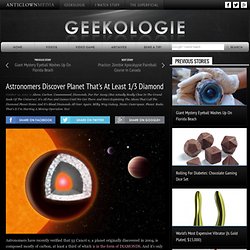
And it's only 40-light years away! Travel at the speed of light for 40 years and you're there. Another 40 years back to earth and getting engaged won't be such a strain on the wallet! "This is our first glimpse of a rocky world with a fundamentally different chemistry from Earth," lead researcher Nikku Madhusudhan of Yale University said in a statement.
"The surface of this planet is likely covered in graphite and diamond rather than water and granite. " So here's the plan: get drunk and forget about it. Thanks to Bria and Tickles The Randy Pangolin, who agree space diamonds are cooler than earth diamonds because, you know, space and stuff. Hello, Tiffanys? Astronomers discover gigantic diamond planet. LONDON — Forget the diamond as big as the Ritz.
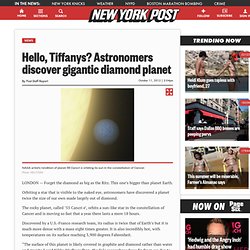
This one’s bigger than planet Earth. Orbiting a star that is visible to the naked eye, astronomers have discovered a planet twice the size of our own made largely out of diamond. The rocky planet, called ’55 Cancri e’, orbits a sun-like star in the constellation of Cancer and is moving so fast that a year there lasts a mere 18 hours. Discovered by a U.S. -Franco research team, its radius is twice that of Earth’s but it is much more dense with a mass eight times greater. “The surface of this planet is likely covered in graphite and diamond rather than water and granite,” said Nikku Madhusudhan, the Yale researcher whose findings are due to be published in the journal Astrophysical Journal Letters. The study — with Olivier Mousis at the Institut de Recherche en Astrophysique et Planetologie in Toulose, France — estimates that at least a third of the planet’s mass, the equivalent of about three Earth masses, could be diamond.
Do Blingons live there? Nearby planet made from diamond. Illustration of the interior of 55 Cancri e — an extremely hot planet with a surface of mostly graphite surrounding a thick layer of diamond, below which is a layer of silicon-based minerals and a molten iron core at the center.Haven Giguere Move over, Hope Diamond.
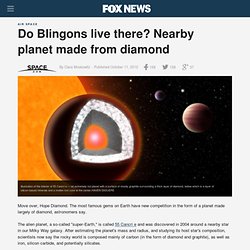
The most famous gems on Earth have new competition in the form of a planet made largely of diamond, astronomers say. The alien planet, a so-called "super-Earth," is called 55 Cancri e and was discovered in 2004 around a nearby star in our Milky Way galaxy. After estimating the planet's mass and radius, and studying its host star's composition, scientists now say the rocky world is composed mainly of carbon (in the form of diamond and graphite), as well as iron, silicon carbide, and potentially silicates. Scientists discover planet made of diamond. Please support our site by enabling javascript to view ads.

In a galaxy far far away, the people of a planet known as '55 Cancri e' speak Blingon. Scientists believe they have found a planet made up almost entirely of diamond. Planet 55 Cancri e orbits a sun-like star in the constellation of Cancer. According to Reuters, it is moving so fast that a year there lasts a mere 18 hours. According to ScienceBlog, the planet is also twice the size of Earth, with daily temperatures reaching close to 4,000 degrees Fahrenheit. Nikku Madhusudhan, the Yale researcher whose findings are due to be published in the journal Astrophysical Journal Letters, "This is our first glimpse of a rocky world with a fundamentally different chemistry from Earth. Nearby super-Earth likely a diamond planet. New research led by Yale University scientists suggests that a rocky planet twice Earth’s size orbiting a nearby star is a diamond planet.

“This is our first glimpse of a rocky world with a fundamentally different chemistry from Earth,” said lead researcher Nikku Madhusudhan, a Yale postdoctoral researcher in physics and astronomy. “The surface of this planet is likely covered in graphite and diamond rather than water and granite.” The paper reporting the findings has been accepted for publication in the journal Astrophysical Journal Letters. The planet — called 55 Cancri e — has a radius twice Earth’s, and a mass eight times greater, making it a “super-Earth.” It is one of five planets orbiting a sun-like star, 55 Cancri, that is located 40 light years from Earth yet visible to the naked eye in the constellation of Cancer. Astronomers discover planet made of diamond. Nearby Exoplanet Could Be Covered With Diamond. Want to stay on top of all the space news?
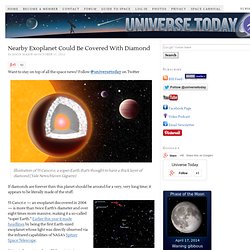
Follow @universetoday on Twitter Illustration of 55 Cancri e, a super-Earth that’s thought to have a thick layer of diamond (Yale News/Haven Giguere) If diamonds are forever then this planet should be around for a very, very long time; it appears to be literally made of the stuff. 55 Cancri e — an exoplanet discovered in 2004 — is more than twice Earth’s diameter and over eight times more massive, making it a so-called “super Earth.” Earlier this year it made headlines by being the first Earth-sized exoplanet whose light was directly observed via the infrared capabilities of NASA’s Spitzer Space Telescope. Nearby super-Earth likely a diamond planet. Illustration of the interior of 55 Cancri e — an extremely hot planet with a surface of mostly graphite surrounding a thick layer of diamond, below which is a layer of silicon-based minerals and a molten iron core at the center.
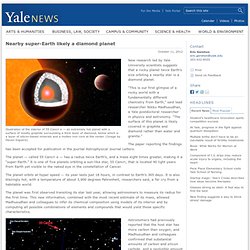
(Image by Haven Giguere) New research led by Yale University scientists suggests that a rocky planet twice Earth's size orbiting a nearby star is a diamond planet. “This is our first glimpse of a rocky world with a fundamentally different chemistry from Earth,” said lead researcher Nikku Madhusudhan, a Yale postdoctoral researcher in physics and astronomy. “The surface of this planet is likely covered in graphite and diamond rather than water and granite.” The paper reporting the findings has been accepted for publication in the journal Astrophysical Journal Letters. Light From a ‘SuperEarth’ Detected for the First Time. Want to stay on top of all the space news?
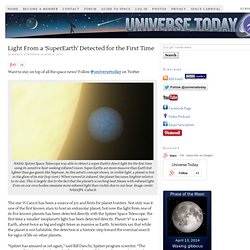
Follow @universetoday on Twitter NASA's Spitzer Space Telescope was able to detect a super Earth's direct light for the first time using its sensitive heat-seeking infrared vision. A planet made of diamond. Super-Earth Planet Likely Made of Diamond. Move over, Hope Diamond.
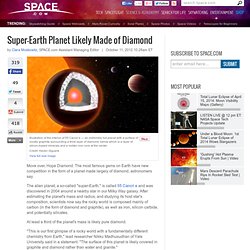
The most famous gems on Earth have new competition in the form of a planet made largely of diamond, astronomers say. The alien planet, a so-called "super-Earth," is called 55 Cancri e and was discovered in 2004 around a nearby star in our Milky Way galaxy. After estimating the planet's mass and radius, and studying its host star's composition, scientists now say the rocky world is composed mainly of carbon (in the form of diamond and graphite), as well as iron, silicon carbide, and potentially silicates. At least a third of the planet's mass is likely pure diamond. Surprise! Alien Planet Made of Diamond Discovered.
A newly discovered alien planet that formed from a dead star is a real diamond in the rough.
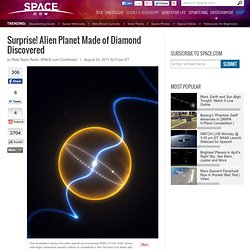
The super-high pressure of the planet, which orbits a rapidly pulsing neutron star, has likely caused the carbon within it to crystallize into an actual diamond, a new study suggests. The composition of the planet, which is about five times the size of Earth, is not its only outstanding feature. [Illustration of the diamond alien planet] The planet's parent star is a special kind of flashing star known as a millisecond pulsar, a rapidly rotating neutron star formed from a supernova. Oozing Super-Earth: Images of Alien Planet 55 Cancri e. Alien Super-Earth Light Seen for 1st Time.
This story was updated May 9 at 6:37 p.m. ET. Light from an alien "super-Earth" twice the size of our own Earth has been detected by a NASA space telescope for the first time in what astronomers are calling a historic achievement. NASA's infrared Spitzer Space Telescope spotted light from the alien planet 55 Cancri e, which orbits a star 41 light-years from Earth. A year on the extrasolar planet lasts just 18 hours. Alien Planet Nearly Dense as Lead. Astronomers have pinned down some details of an exotic nearby alien planet that's almost as dense as lead.
The exoplanet, called 55 Cancri e, is 60 percent larger in diameter than Earth but eight times as massive, researchers revealed Friday (April 29). That makes the alien world the densest solid planet known -- twice as dense as Earth. [Gallery: The Strangest Alien Planets] Bizarre alien super-Earth planet probably made of diamond. Move over, Hope Diamond. The most famous gems on Earth have new competition in the form of a planet made largely of diamond, astronomers say.
Skip to next paragraph Subscribe Today to the Monitor Click Here for your FREE 30 DAYS ofThe Christian Science MonitorWeekly Digital Edition. Astronomers find a planet made of diamond. Updated Fri 12 Oct 2012, 10:22am AEDT Forget the diamond as big as the Ritz - astronomers believe they have found one bigger than Earth. Orbiting a star that is visible to the naked eye, astronomers have discovered a planet twice the size of our own made largely out of diamond.
The rocky planet, called 55 Cancri e, orbits a sun-like star in the constellation of Cancer and is moving so fast that a year there lasts a mere 18 hours. Discovered by a US-Franco research team, its radius is twice that of Earth's but it is much more dense with a mass eight times greater. It is also incredibly hot, with temperatures on its surface reaching 1,648 degrees Celsius. "The surface of this planet is likely covered in graphite and diamond rather than water and granite," said Yale researcher Nikku Madhusudhan, whose findings are due to be published in the journal Astrophysical Journal Letters.